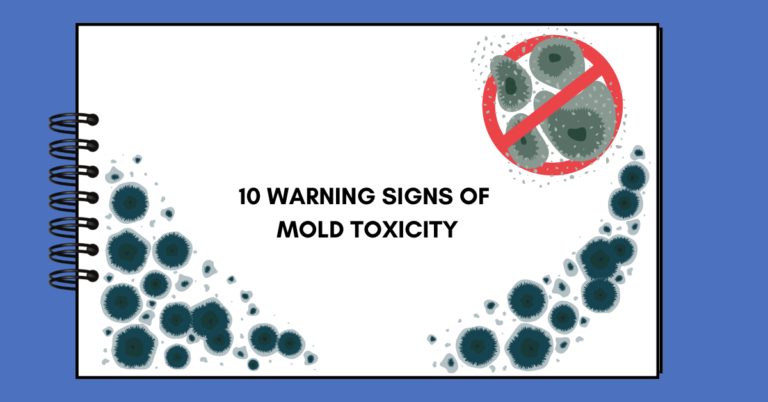Mold toxicity is a pressing health concern often underestimated in its severity. Mold, a form of fungus, can proliferate both indoors and outdoors, posing significant health risks when inhaled or ingested. Understanding the warning signs of mold toxicity is crucial for early detection and effective intervention to prevent further health complications. In this comprehensive article, we delve into the 10 warning signs of mold toxicity, explore its causes, and provide insights into prevention and treatment strategies.
1. Respiratory Issues
One of the hallmark signs of mold toxicity is respiratory problems. Mold spores, when inhaled, can trigger inflammation in the airways, leading to symptoms such as:
- Persistent coughing
- Wheezing
- Shortness of breath
- Chest tightness
These respiratory issues can mimic asthma symptoms and may exacerbate existing respiratory conditions.
2. Skin Irritation
Exposure to mold can cause skin irritation, manifesting as:
- Rashes
- Hives
- Itching
- Redness or inflammation of the skin
Individuals with sensitive skin or existing dermatological conditions may experience more pronounced skin reactions.
3. Fatigue
Mold toxicity can contribute to chronic fatigue, where individuals experience persistent tiredness and lack of energy even after adequate rest. This fatigue can significantly impact daily activities and quality of life.
4. Headaches
Frequent headaches are another common warning sign of mold toxicity. These headaches may range from mild to severe and can be accompanied by other neurological symptoms like dizziness or brain fog.
5. Cognitive Impairment
Mold exposure may impair cognitive function, leading to:
- Difficulty concentrating
- Memory problems
- Cognitive fog or confusion
These cognitive changes can affect work performance, academic achievement, and overall cognitive abilities.
6. Nausea and Digestive Issues
Some individuals exposed to mold may experience gastrointestinal symptoms such as:
- Nausea
- Vomiting
- Digestive discomfort
These symptoms can be particularly distressing and may indicate mold-related toxicity.
7. Joint Pain
Mold toxicity can contribute to joint pain and inflammation, resembling symptoms of arthritis. Individuals may experience:
- Joint stiffness
- Aches and pains
- Reduced range of motion
These joint issues can interfere with mobility and daily activities.
8. Sensitivity to Light
Some people with mold toxicity may develop sensitivity to light, known as photophobia. This can lead to eye discomfort, headaches, and avoidance of bright light environments.
9. Mood Changes
Mold exposure can impact mood and emotional well-being, leading to:
- Depression
- Anxiety
- Irritability
These mood changes can significantly affect mental health and overall quality of life.
10. Recurrent Infections
Weakened immune function due to mold toxicity can increase susceptibility to infections, resulting in:
- Frequent respiratory infections
- Sinus infections
- Prolonged recovery from illnesses
These recurrent infections may be more severe and challenging to treat in individuals with mold-related immune suppression.
Understanding the Causes of Mold Toxicity
Several factors contribute to mold toxicity:
- Environmental Conditions: Mold thrives in damp, humid environments with poor ventilation. Areas prone to water damage, leaks, or high humidity levels are breeding grounds for mold growth.
- Exposure to Toxic Mold: Certain types of mold, such as black mold (Stachybotrys chartarum), produce mycotoxins that are particularly harmful when inhaled or ingested.
- Pre-Existing Health Conditions: Individuals with allergies, asthma, or compromised immune systems are more susceptible to the adverse effects of mold toxicity.
- Prolonged Exposure: Continuous exposure to mold-infested environments increases the risk of developing mold-related health issues.
Preventing Mold Toxicity
Taking proactive measures to prevent mold growth and exposure is crucial:
- Maintain Dry Conditions: Keep indoor spaces dry and well-ventilated to discourage mold growth. Address water leaks, spills, and moisture buildup promptly.
- Use Mold-Resistant Materials: Opt for mold-resistant building materials in construction and renovation projects to minimize mold proliferation.
- Regular Cleaning: Clean and inspect areas prone to mold growth, such as bathrooms, kitchens, and basements, regularly.
- Ventilation: Ensure proper ventilation in bathrooms, kitchens, and other moisture-prone areas to reduce humidity levels and prevent mold buildup.
- Monitor Indoor Humidity: Keep indoor humidity levels below 50% to discourage mold growth. Use dehumidifiers if necessary, especially in humid climates.
Treating Mold Toxicity
If mold toxicity is suspected, prompt intervention is crucial:
- Source Removal: Identify and remove the source of mold contamination in indoor environments. Professional mold remediation may be necessary for extensive contamination.
- Improve Indoor Air Quality: Use air purifiers and high-efficiency particulate air (HEPA) filters to reduce airborne mold spores and improve indoor air quality.
- Medication: Depending on symptoms, healthcare providers may prescribe medications such as antihistamines, nasal corticosteroids, or asthma medications to alleviate respiratory and allergic reactions.
- Detoxification: Detox protocols may be recommended to eliminate toxins from the body and support overall health.
- Nutritional Support: A balanced diet, hydration, and nutritional supplements can aid in recovery from mold-related health issues.
Conclusion
Recognizing the 10 warning signs of mold toxicity is crucial for early detection and intervention. By understanding the causes, prevention strategies, and treatment options, individuals can mitigate the risks associated with mold exposure and safeguard their health and well-being. Seeking medical evaluation and professional assistance for mold remediation is paramount in addressing mold-related health concerns effectively.

